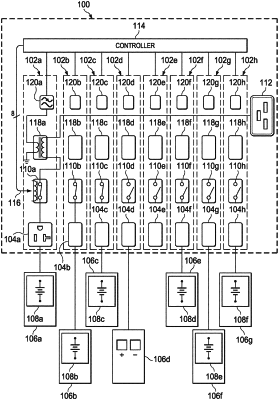| CPC H02J 7/00714 (2020.01) [H02J 7/0013 (2013.01); H02J 7/0047 (2013.01)] | 19 Claims |

|
1. A power control system comprising:
a plurality of power ports;
a plurality of relays for each respective one port of the plurality of power ports, each relay of the plurality of relays independently changeable between an ON state, where power is supplied to the respective one port, and an OFF state, where power is not supplied to the respective port;
a plurality of current sensors for each respective one port of the plurality of power ports, each current sensor of the plurality of current sensors operable to measure an electrical current at the respective one port;
a controller operable to perform a sequential sweep by performing the steps (a) through (e) below, sequentially for a set of OFF state relays, the set of OFF set relays defined as relays, from the plurality of relays, that are in the OFF state, the set of OFF state relays being numbered sequentially from 1, and n is set to 1:
(a) providing the ON state signal to an n-th relay of the set of OFF state relays;
(b) determining whether, when the n-th relay is changed to the ON state, a total current estimate, determined as a sum of electrical current through all of the plurality of current sensors, is less than a maximum current limit;
(c) if the total current estimate is less than the maximum current limit, keeping the n-th relay provided with the ON state signal in the ON state;
(d) if the total current estimate is greater than the maximum current limit, then turning the n-th relay provided with the ON state signal in the OFF state;
(e) incrementing n to be n+1 and repeating steps (a) through (d) until the n-th relay is a final sequential relay of the set of OFF state relays; and
repeating the sequential sweep at predetermined time intervals with remaining relays that are in the set of OFF state relays.
|